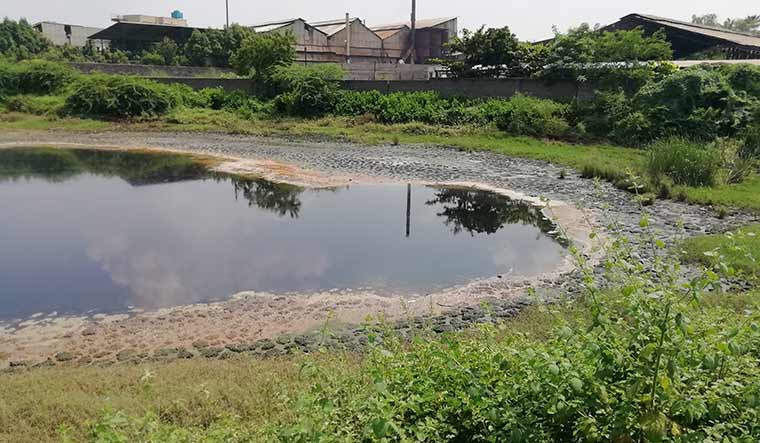Isnapur falls just outside the greater Hyderabad region. This small town of 30,000 people has roughly around 30 hospitals and clinics—an anomalous number for a town of its size. Dr Dayakar Reddy, director of Dr Ram Reddy Memorial Hospital, says that a spectre of drug resistance is haunting this industrial township.
“A lot of patients come to us with skin problems,” says Reddy. “It can be a simple allergy, eczema or psoriasis. In many cases, medicines were not working. We referred them to super-speciality hospitals in Hyderabad. We have seen something similar in patients with respiratory disorders and other diseases, too.”
In 2017, scientists found a strain of bacteria in the Isnapur lake that are resistant to certain antibiotics. The same year, around two lakh fish were found dead in the lake due to poisoning. The lake is surrounded by around 400 factories and industrial units comprising the Pashamylaram industrial area. The locality houses one of the three main pharmaceutical clusters of the region. For long, these drug manufacturers have been accused of polluting the water bodies and open lands by dumping untreated chemical effluents.
Locals and activists have been arguing that illegal practices of the industries are a major reason for the deteriorating health of the residents. There are no concrete studies, yet, to prove that the mutated bacteria found in Isnapur lake have entered human bodies. But what is certain is that some of the patients are not responding to medicines the way they should.
The Kazipally lake, situated near the Kazipally industrial area of Hyderabad, is also a hotspot of multi-drug resistant bacteria. In some of the local clinics in the area, children were being prescribed antibiotics of very high dose (usually meant for adults), as they were not recovering with the usual treatment. A little far away is Patancheru-Bollarum industry cluster, which is also a residential area apart from being an industrial hub. Here, some doctors have started a new practice of prescribing certain medicines based on whether the patients reside in the industrial belt or not.
In 2014, D.G. Joakim Larsson of Gothenburg University, Sweden, published a study. He examined the samples drawn from Kazipally lake and compared it with samples taken from a lake in Sweden. The study found that the Kazipally lake harboured a wide range of resistance genes (81 identified gene types) against essentially every major class of antibiotics. Larsson also found that the resistance genes of bacteria were 7,000 times more abundant compared with the Swedish lake.
Christopher Lubert from Leipzig University hospital in Germany also examined water samples from localities close to pharma factories in Hyderabad. According to him, multi drug-resistant bacteria were found in the water bodies, and the effluents from the drug-manufacturing plants may aggravate the situation.
Hyderabad is a pharma powerhouse with top industry names like Dr Reddy’s Laboratories and Aurobindo Pharma emerging from the city. Successive governments had cleared the construction of bulk drug manufacturing units to the west of Hyderabad. Three pharma clusters now dot the outskirts of greater Hyderabad. Currently, there are around 200 pharma factories in this region. Pharma exports from Telangana stand at more than Rs17,000 crore per year, and most of these bulk drugs are made for Europe and the US markets.
While the Telangana government is aggressively encouraging the pharma industry, activists are fighting tooth and nail to keep a check on the latter’s industrial practices. Dr Kishan Rao, who runs a hospital in Lingampally, has spent half of his life in courts and leading mass movements against industrial pollution in the area. He, along with his team, have found that around 43 lakes in Hyderabad are heavily polluted. Rao rues that despite court orders, groundwater and lakes continue to be “poisoned” by pharma firms. “According to rules, it is mandatory for pharma effluents to be transported to a common effluent treatment plant. Is it happening that way?” he asks. Dumping pharma waste in lakes and open fields at night has been a common practice in the area for years. Another shocking disposal method is drilling borewells within the factory premises to discreetly pump effluents into ground.
Also read
- Amid rising fever cases, IMA advises to avoid antibiotics. Here's why
- Scientists discover medieval medicine that could be a useful future antibiotic
- OPINION: Time for India to step up fight against antimicrobial resistance
- India leading the way in averting antibiotic apocalypse
- The killers within
- Need more laws to deal with antimicrobial resistance
A local journalist-turned-activist who does not wish to be named, says: “The illegal methods to dispose waste must have come down due to increased awareness and stricter rules. But, these industries still do it. Otherwise, why will groundwater have high suspended particulate matter? At the end of the day, the managements are more interested in making profits and not spending on safe environment.” In 2018-2019, the state pollution control board sent closure notices to around 20 pharma companies for various violations.
In 2017, Dayananda Siddavattam from the University of Hyderabad conducted a preliminary study on the relation between drug-resistant bugs and pollution. “I tried to enumerate resistant bugs found in effluent canals and nearby lakes, and also in water bodies which do not have any drug-manufacturing unit in its vicinity,” he says. “I found resistant bacteria all over. But the frequency is more in lakes close to [industrial] units. The bacteria were resistant to routinely-used drugs like tetracycline and beta-lactam derivatives.”
However, Siddavattam rejects the idea that “superbugs” exist in the lakes of Hyderabad. “Superbugs are resistant to all the antibiotics,” he says. “The resistant bugs are there everywhere, but that does not mean they are superbugs. Superbugs usually emerge in clinical settings.”
As researchers go about their job, the pollution control board officials and drug manufacturers maintain that all norms are being followed. But in the industrial area, water is toxic, air is nauseating and people continue to flock to hospitals.


